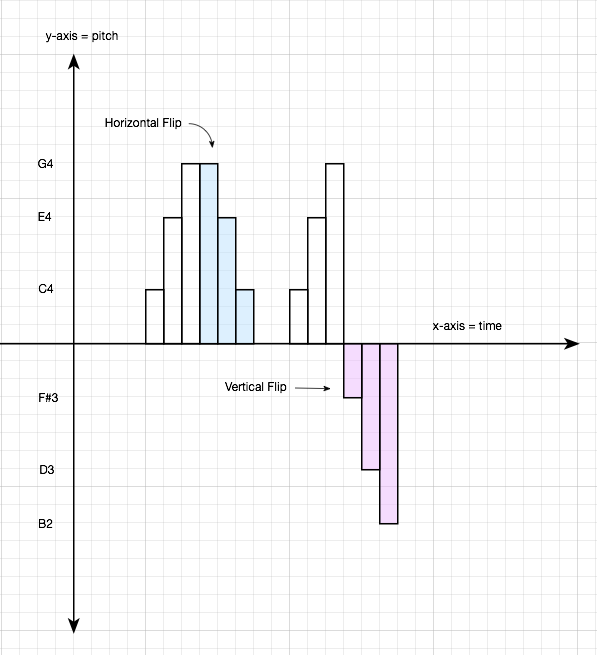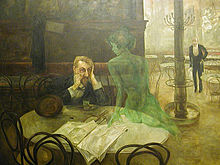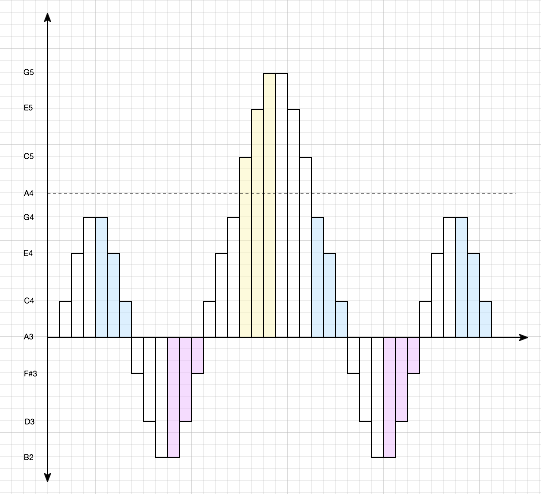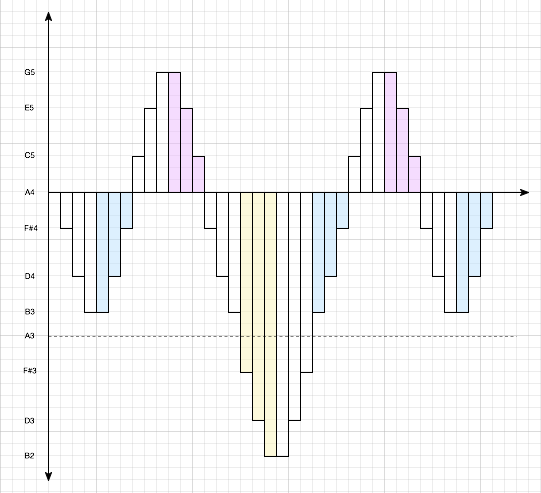There is a virtual festival of things that can be done with computer algorithms, and some of the more advanced techniques are easiest to understand when you are conversant with Joseph Schillinger's System of Musical Composition (SoMC) . . .
For those folks who might not be familiar with SoMC, there are two vastly useful basic principles:
[
NOTE: NOTION 3 is ideal for making sense of SoMC, especially when one is not so skilled in reading music notation and playing piano . . . ]
(1) Complex rhythm patterns are constructed by combining simple rhythm patterns . . .
For example, consider that there are five musicians and each musician plays a drum or cymbal on a specific beat, where the first musician plays a kick drum on every beat; the second musician plays a ride cymbal on every other beat; the third musician plays a hi-hat on every third beat; the fourth musician plays a snare drum rimshot on every fourth beat; and the fifth musician plays a high tom-tom on every fifth beat . . .
This creates a moderately complex rhythm pattern, and the first five measures are shown in the following screen capture:

The high-level rhythm pattern is 30 measures, where the length in measures of the rhythm pattern is determined when all the drums and cymbals play on the same beat, which occurs in the 30th measure . . .
[
NOTE: The true length of rhythm patterns and everything else is very important in SoMC, in part because it is a key aspect of understanding and controlling symmetry and asymmetry . . . ]
This is the way the 1-2-3-4-5 rhythm pattern sounds at a tempo of 182 beats per minute (BPM), and the pattern is played three times (90 measures):
"1-2-3-4-5 Rhythm Pattern" (The Surf Whammys) -- MP3 (4.5MB, 298-kbps [VBR], approximately 2 minutes and 4 seconds)This rhythm pattern is relatively easy to follow, but if you want to have a bit of FUN with musicians and singers, then you can do this exercise, which can be done with whatever is handy if there are no drums, cymbals, and Latin percussion instruments available . . .
The amusing aspect is that most musicians and singers initially will think that this is easy to do, but it is
not so easy to do, especially when the numbers are higher and odd (for example, 2-3-5-7-9) . . .
However, this is only an intermediate step in creating a rhythm pattern in SoMC, because additional steps do the same thing that occurs after you listen to the rhythm pattern for a while, which is done with a series of flexible rules that reveal the high-level rhythm pattern as sum of all the individual beats . . .
(2) Scales, melodies, chords, harmony parts, counterpoint, and all that stuff follows similar rules, but the pitch components are more obvious, although once you realize that drums, cymbals, and Latin percussion instruments are melodic when properly tuned, it is not so difficult to understand that the pitch-based aspects are included in the rhythm pattern stuff . . .
The primary difference in (1) and (2) is that the pitch-based stuff is graphed, where the x-axis represents beats and the y-axis represents semitones or half-steps . . .
This is the 1-2-3-4-5 rhythm pattern with the drumkit instruments replaced with an electric bass, electric fuzz guitar, and some synthesizers:
"1-2-3-4-5 Melody Pattern" -- MP3 (4.5MB, 304-kbps [VBR], approximately 2 minutes and 4 seconds)OBSERVATIONSOnce the basic concept of using mathematics and geometrical patterns begins making a bit of sense, I think it becomes obvious that a good bit of the work done in composing a song can be enhanced with computer-based tools, especially since much of the information pertaining to rhythm patterns, scales, chords, melodies, harmonies, counterpoint, and so forth exists in clearly defined rules that are easily put into algorithmic form for use in computer programs, where for example the rules for different types of vocal harmonies generally are well-defined . . .
On the geometrical side, one of the more useful insights from the SoMC involves what I generally call "flipping", where you begin with a simple phrase and then "flip it" in one of several ways to create a new phrase, which is easiest to understand when you have graphed a few melodies and studied them for a while . . .
Two of the simplest types of "flips" are (a) horizontal and (b) vertical, where a horizontal "flip" plays the phrase backward but keeps the pitch of the notes the same, while a vertical "flip" changes the pitch of the notes . . .
For example, consider the phrase C4-E4-G4, which are the notes of C Major triad . . .
If you do a horizontal "flip", then the resulting pattern is C4-E4-G4-G4-E4-C4, but if you do a vertical "flip", then the resulting pattern is C4-E4-G4-F#3-D3-B2, as shown in the following diagram, where (a) the x-axis shows the duration of each note, which in this example are quarter notes and (b) the y-axis shows the pitch of each note, which in this example are semitone units with A3 being the reference pitch (y = 0) . . .
[
NOTE: I made a tiny mistake in the first version of the diagram. The problem was that I forget that A3 to C4 is three semitones, as is E4 to G4, but I fixed it and changed the names of the vertically "flipped" notes . . . ]

If you do a bit of intuitive dot connecting, it should be easy to see (a) that there now are several patterns all derived from C4-E4-G4 and (b) that the patterns are mathematically and geometrically related . . .
And if you study these apparently simple note patterns for a while, which is easier (a) if you play electric bass or electric guitar and (b) if you taught yourself how to play "by ear", then with a few more variations of "flips" it becomes obvious that these are the notes for several classic
Rhythm and Blues,
Heavy Metal, and
Rock phrases . . .
Curiously, C4-E4-G4 are the notes of a Major triad, but B2-D3-F#3 are the notes of a Minor triad, really . . .
Really! THOUGHTSNOTION 3 does a few very basic things which are helpful, where for example (a) you can select a series of notes and do a transformation based on a specific interval, which is easy to do, and (b) you can create a new staff and copy notes from an existing staff to the new staff, followed by doing a transformation, which takes a bit longer but also generally is easy to do . . .
There is so much stuff that can be done algorithmically that it is a bit beyond mind-boggling, and there are a few basic requirements, all of which I have explained in reasonably sufficient detail in the topic "NOTION 4: Vision for the Future" in this FORUM . . .
NOTION 4: Vision for the Future (Notion Music FORUM)For example, consider a melody as being points on a curve, which is not a difficult thing to do in graphic user interface (GUI) programming . . .
When you do this, the melody becomes a continuous curve, and I suggest that having a set of vector drawing tools will be vastly helpful for composers, since instead of having to move, adjust, and fine-tune a melody one note at a time, it should be both possible and practical to switch to vector curve mode and then to work with a melody as it were a continuous curve in a drawing program like Photoshop or iDraw (
both of which are personal favorites) . . .
I have no idea how musicians who did everything solely in the formal music theory path view stuff, but I understand the way that "play by ear" musicians think, and the basic reality is that once you learn some where in the range of 50 to 100 popular songs "by ear", then you soon have the required epiphany, which to be specific is that nearly every popular song is a virtual festival of phrases "borrowed'" from other popular songs . . .
Perhaps more correctly, once you learn the electric bass parts for 50 to 100 popular songs, then you know the electric bass patterns for every popular song--past, present, and future--which also is the case with lead guitar solos . . .
On the formal music theory side of the universe, I suppose that this maps to learning and understanding the basic set of scales, chords, arpeggios, and so forth, which essentially is the same thing but not in a way that maps so immediately to composing silly
DISCO and
Pop songs about ladies underpants . . .
For example, as part of the research for YouTube blurb for the Surf Whammys fabulous song, "(I Want) Angela Gossow's Underpants (Ya-Ya-Ya)", I noticed that something about "Purple Haze" (The Jimi Hendrix Experience) was ringing a distant but oddly proximal bell, and after a bit of pondering I had the required epiphany . . .
"In The Hall Of The Mountain King" (Edvard Grieg) -- YouTube music video"Purple Haze" (The Jimi Hendrix Experience) -- YouTube music video"(I Want) Angela Gossow's Underpants (Ya-Ya-Ya)" (The Surf Whammys) -- YouTube music videoDoing this stuff is not so difficult, but (a) it takes a while and (b) it could be a lot easier, which is where there are stellar possibilities for Notion Music to add significant compositional tools and techniques to the next version of NOTION, which is fabulous . . .
Fabulous! 






